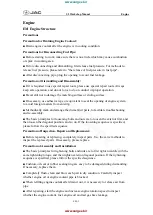
9-35
09
WARNING
Recommended pressures must be main-
tained for the best ride, vehicle han-
dling, and minimum tire wear.
Over-inflation or under-inflation can re-
duce tire life, adversely affect vehicle
handling, and lead to sudden tire failure
that could result in loss of vehicle con-
trol resulting in an accident.
Severe under-inflation can lead to se-
vere heat build-up, causing blowouts,
tread separation and other tire failures
that can result in the loss of vehicle con-
trol resulting in an accident. This risk is
much higher on hot days and when driv-
ing for long periods at high speeds.
NOTICE
• Underinflation also results in exces-
sive wear, poor handling and reduced
fuel economy. Wheel deformation
also is possible. Keep your tire pres-
sures at the proper levels. If a tire fre-
quently needs refilling, we recom-
mend that the system be checked by
an authorized HYUNDAI dealer.
• Overinflation produces a harsh ride,
excessive wear at the center of the
tire tread, and a greater possibility of
damage from road hazards.
Checking tire inflation pressure
Check your tires once a month or more.
Also, check the tire pressure of the spare
tire.
How to check
Use a good quality gage to check tire
pressure. You can not tell if your tires are
properly inflated simply by looking at
them. Radial tires may look properly in-
flated even when they’re underinflated.
Remove the valve cap from the tire valve
stem. Press the tire gauge firmly onto the
valve to get a pressure measurement. If
the cold tire inflation pressure matches
the recommended pressure on the tire
and loading information label, no further
adjustment is necessary. If the pressure is
low, add air until you reach the recom-
mended pressure. Make sure to put the
valve caps back on the valve stems. With-
out the valve cap, dirt or moisture could
get into the valve core and cause air leak-
age. If a valve cap is missing, install a new
one as soon as possible.
If you overfill the tire, release air by push-
ing on the metal stem in the center of the
tire valve. Recheck the tire pressure with
the tire gauge. Be sure to put the valve
caps back on the valve stems. Without
the valve cap, dirt or moisture could get
into the valve core and cause air leakage.
If a valve cap is missing, install a new one
as soon as possible.
















































